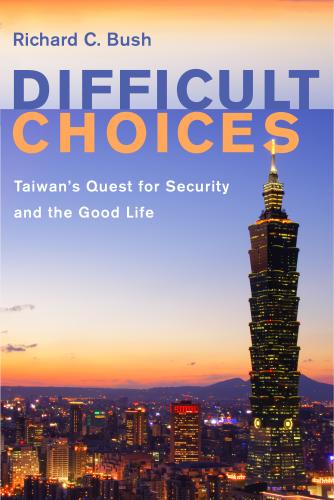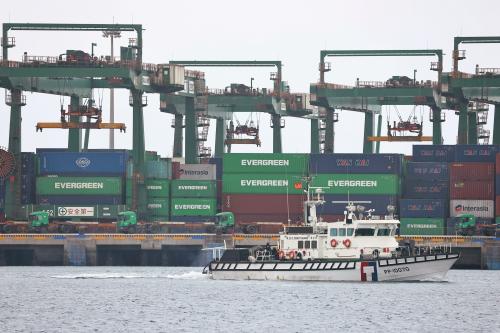Taiwan’s leaders need to be honest with their people about the security threat Taiwan faces and the trade-offs that will be required to meet the threat, and need to decide what military capabilities to prioritize, writes Ryan Hass. The greater alignment that Taiwan’s leaders of both major parties can reach on these questions, and the more enduring that Taiwan’s defense concept becomes, the greater the impact Taipei will have on their adversary’s calculations about the risks of using force in pursuit of political objectives. This piece originally appeared in the Taipei Times.
For Taiwan, credible deterrence against Chinese military aggression requires the alchemy of multiple elements. These include a strong will to fight among the population, powerful military capabilities, and close coordination with other actors — including the United States and Japan — whose vital interests would be affected by any conflict. One of the most important elements, though, is strong and sustained internal cohesion in support of a clear defense concept.
Combining all these elements together is a formidable challenge. While there are ongoing debates about whether a People’s Republic of China (PRC) military attack is imminent, or whether an invasion is tied to any predetermined timeline, there is not debate over the observable reality that PRC military capabilities are expanding. With growing capabilities has come a growing willingness by Beijing to intensify military pressure on Taiwan. China’s dispatch of 148 warplanes through Taiwan’s air defense identification zone in early October is but the latest reminder of this reality.
In the face of these trends, Taiwan’s leaders are forced to find a balance between several competing priorities. On one hand, Taipei needs to decide how to respond to Beijing’s growing grey zone military pressure. At the same time, Taiwan needs to develop capabilities to deter high-end military contingencies, including but not limited to full-scale invasion. And it needs to develop responses that fit within the scope of its fiscal constraints and reflect a sense of urgency to deal with any contingencies that may arise.
Fortunately, there has been deep and sustained thinking on these types of questions for some time. For over a decade, U.S. and Taiwan military planners have been quietly deliberating over how Taiwan can most effectively defend itself. These discussions have carried forward through Kuomintang (KMT) and Democratic Progressive Party (DPP) administrations in Taiwan and cut across Democratic and Republican administrations in the United States.
A major output of these efforts has been the idea of a “porcupine strategy,” an approach that seeks to exploit Taiwan’s geographic and innovative advantages to create a painfully costly target for Beijing to seek to subdue. This approach moves Taiwan away from seeking to assert sea control, air superiority, and long-range strike capability toward an emphasis on preventing China’s ability to occupy Taiwan with military force. In this concept, Taiwan forces would concentrate the battlefield on their geographic advantages by attacking invading forces at their points of maximum vulnerability near Taiwan’s shores, rather than seeking to engage forces on the mainland or in the Taiwan Strait.
To work, such an approach requires Taiwan to acquire large amounts of small things that could signal to an adversary that any attempt to impose a military outcome on Taiwan would carry significant costs and risks. Capabilities that fit this profile include highly mobile coastal defense cruise missiles, short-range air defense, naval mines, mobile artillery, advanced surveillance assets, and unmanned aerial and unmanned underwater vehicles, among others. As David Helvey, one of the principal American intellectual contributors to the development of this asymmetric concept previously noted, all of these systems are “far less expensive to operate and maintain, and are more survivable, compared to more conventional platforms such as fighter aircraft or large naval vessels.”
In her May 2020 inaugural address at the start of her second term, President Tsai Ing-wen seemed to embrace this approach, stating that her first national defense objective was “accelerating the development of our asymmetrical capabilities.” In subsequent public remarks, she said she was “committed to accelerating the development of asymmetric capabilities under the Overall Defense Concept.”
Tsai’s statement was warmly welcomed in Washington, where support for a “porcupine strategy” is generally quite strong in the U.S. government and in the expert community. The seemingly uneven follow-through by Taiwan’s Ministry of National Defense (MND) in implementing the defense concept in the years since has raised more questions than answers, though.
There is a perception in some quarters of Washington that the asymmetric approach President Tsai endorsed has been stretched beyond recognition in recent years by a recalcitrant MND. According to this line of thought, the MND wants to preserve legacy systems and outdated defense concepts and is dragging its feet on major changes toward a more mobile, survivable force.
Ultimately, Taiwan’s leaders will need to be honest with the people of Taiwan about the threat Taiwan faces and the trade-offs that will be required to meet the threat. Tough decisions will need to be made and then carried out. Leaders will need to decide what military capabilities to prioritize. They will need to decide whether the goal is to try to destroy the adversary’s capabilities or deny its capacity to occupy Taiwan. They will need to determine the proper balance between spending on social services for an ageing society versus defense, and whether current tax revenue levels are sufficient to cover these dueling demands.
The greater alignment that Taiwan’s leaders of both major parties can reach on these questions, and the more enduring that Taiwan’s defense concept becomes, the greater the impact Taipei will have on their adversary’s calculations about the risks of using force in pursuit of political objectives. The risks facing Taiwan are significant, but conflict is not inevitable.
The Brookings Institution is committed to quality, independence, and impact.
We are supported by a diverse array of funders. In line with our values and policies, each Brookings publication represents the sole views of its author(s).











Commentary
Taiwan’s leaders need to coalesce around a defense concept
November 1, 2021